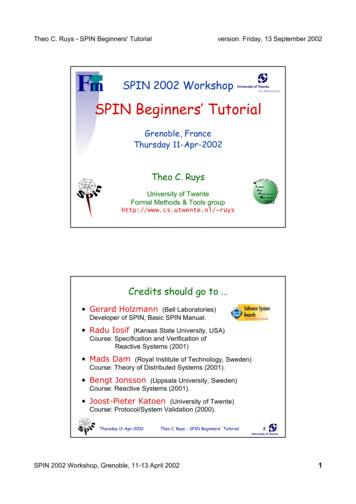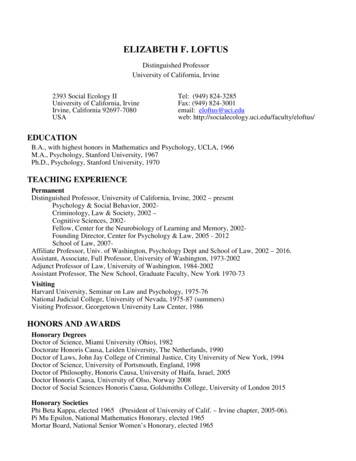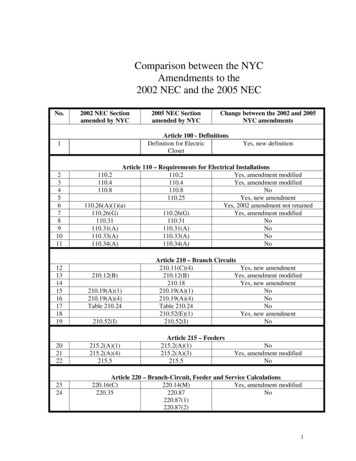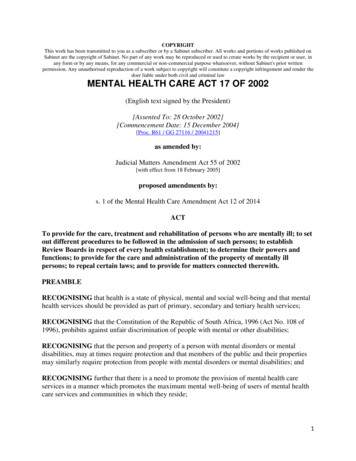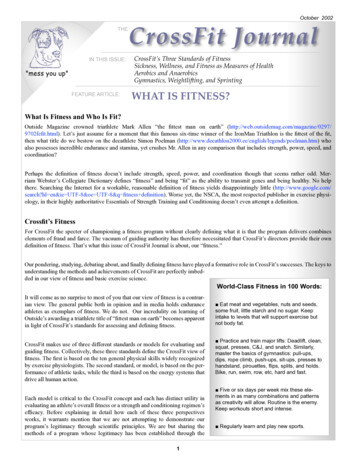
Transcription
October 2002THEIN THIS ISSUE:"mess you up"FEATURE ARTICLE:CrossFit JournalCrossFit’s Three Standards of FitnessSickness, Wellness, and Fitness as Measures of HealthAerobics and AnaerobicsGymnastics, Weightli!ing, and SprintingWHAT IS FITNESS?What Is Fitness and Who Is Fit?Outside Magazine crowned triathlete Mark Allen “the fittest man on earth” .html). Let’s just assume for a moment that this famous six-time winner of the IronMan Triathlon is the fittest of the fit,then what title do we bestow on the decathlete Simon Poelman an.htm) whoalso possesses incredible endurance and stamina, yet crushes Mr. Allen in any comparison that includes strength, power, speed, andcoordination?Perhaps the definition of fitness doesn’t include strength, speed, power, and coordination though that seems rather odd. Merriam Webster’s Collegiate Dictionary defines “fitness” and being “fit” as the ability to transmit genes and being healthy. No helpthere. Searching the Internet for a workable, reasonable definition of fitness yields disappointingly little (http://www.google.com/search?hl en&ie UTF-8&oe UTF-8&q fitness definition). Worse yet, the NSCA, the most respected publisher in exercise physiology, in their highly authoritative Essentials of Strength Training and Conditioning doesn’t even attempt a definition.Crossfit’s FitnessFor CrossFit the specter of championing a fitness program without clearly defining what it is that the program delivers combineselements of fraud and farce. The vacuum of guiding authority has therefore necessitated that CrossFit’s directors provide their owndefinition of fitness. That’s what this issue of CrossFit Journal is about, our “fitness.”Our pondering, studying, debating about, and finally defining fitness have played a formative role in CrossFit’s successes. The keys tounderstanding the methods and achievements of CrossFit are perfectly imbedded in our view of fitness and basic exercise science.World-Class Fitness in 100 Words:It will come as no surprise to most of you that our view of fitness is a contrarian view. The general public both in opinion and in media holds enduranceathletes as exemplars of fitness. We do not. Our incredulity on learning ofOutside’s awarding a triathlete title of “fittest man on earth” becomes apparentin light of CrossFit’s standards for assessing and defining fitness.CrossFit makes use of three different standards or models for evaluating andguiding fitness. Collectively, these three standards define the CrossFit view offitness. The first is based on the ten general physical skills widely recognizedby exercise physiologists. The second standard, or model, is based on the performance of athletic tasks, while the third is based on the energy systems thatdrive all human action.Each model is critical to the CrossFit concept and each has distinct utility inevaluating an athlete’s overall fitness or a strength and conditioning regimen’sefficacy. Before explaining in detail how each of these three perspectivesworks, it warrants mention that we are not attempting to demonstrate ourprogram’s legitimacy through scientific principles. We are but sharing themethods of a program whose legitimacy has been established through the1 Eat meat and vegetables, nuts and seeds,some fruit, little starch and no sugar. Keepintake to levels that will support exercise butnot body fat. Practice and train major lifts: Deadlift, clean,squat, presses, C&J, and snatch. Similarly,master the basics of gymnastics: pull-ups,dips, rope climb, push-ups, sit-ups, presses tohandstand, pirouettes, flips, splits, and holds.Bike, run, swim, row, etc, hard and fast. Five or six days per week mix these elements in as many combinations and patternsas creativity will allow. Routine is the enemy.Keep workouts short and intense. Regularly learn and play new sports.
October 2002testimony of athletes, soldiers, cops, and others whose lives or livelihoods depend on fitness.Crossfit’s First Fitness StandardThere are ten recognized general physical skills. They are cardiovascular/respiratory endurance, stamina, strength, flexibility, power,coordination, agility, balance, and accuracy. (See “General Physical Skills”, pg. 4, for definitions.) You are as fit as you are competentin each of these ten skills. A regimen develops fitness to the extent that it improves each of these ten skills.Importantly, improvements in endurance, stamina, strength, and flexibility come about through training. Training refers to activitythat improves performance through a measurable organic change in the body. By contrast improvements in coordination, agility,balance, and accuracy come about through practice. Practice refers to activity that improves performance through changes in thenervous system. Power and speed are adaptations of both training and practice.Crossfit’s Second Fitness StandardThe essence of this model is the view that fitness is about performing well at any and every task imaginable. Picture a hopper loadedwith an infinite number of physical challenges where no selective mechanism is operative, and being asked to perform fetes randomly drawn from the hopper. This model suggests that your fitness can be measured by your capacity to perform well at these tasksin relation to other individuals.The implication here is that fitness requires an ability to perform well at all tasks, even unfamiliar tasks, tasks combined in infinitelyvarying combinations. In practice this encourages the athlete to disinvest in any set notions of sets, rest periods, reps, exercises, orderof exercises, routines, periodization, etc. Nature frequently provides largely unforeseeable challenges; train for that by striving tokeep the training stimulus broad and constantly varied.Crossfit’s Third Fitness StandardTotal fitness, the fitness that CrossFit promotes and develops, requirescompetency and training in each of these three pathways or engines.Balancing the effects of these three pathways largely determines thehow and why of the metabolic conditioning or “cardio” that we do atCrossFit.Percent of total energyThere are three metabolic pathways that provide the energy for all human action. These “metabolic engines” are known as the phosphagen pathway, the glycolytic pathway, and the oxidative pathway.The first, the phosphagen, dominates the highest-powered activities,those that last less than about ten seconds. The second pathway, the100glycolytic, dominates moderate-powered activities, those that lastup to several minutes. The third pathway, the oxidative, dominateslow-powered activities, those that last in excess of several minutes. Here’s an excellent reference for additional information: uscle/exercise-folder/muscle.html0060130Time (seconds)PhosphagenGlycolyticOxidativeFavoring one or two to the exclusion of the others and not recognizingthe impact of excessive training in the oxidative pathway are arguablythe two most common faults in fitness training. More on that later.Common GroundThe motivation for the three standards is simply to ensure the broadest and most general fitness possible. Our first model evaluatesour efforts against a full range of general physical adaptations, in the second the focus is on breadth and depth of performance, withthe third the measure is time, power and consequently energy systems. It should be fairly clear that the fitness that CrossFit advocatesand develops is deliberately broad, general, and inclusive. Our specialty is not specializing. Combat, survival, many sports, and lifereward this kind of fitness and, on average, punish the specialist.2
October 2002 ## ## " ##%" ) # ) " ) " # # " ( ) %# ## ## %" ##% # & ") ' #%" % ' " # %% # # # ## ' ## ## " " #%" # # !% ) Sickness, Wellness, and FitnessThere is another aspect to the CrossFit brand of fitness that is of great interest and immense value to us. We have observed thatnearly every measurable value of health can be placed on a continuum that ranges from sickness to wellness to fitness. See tableabove. Though tougher to measure, we would even add mental health to this observation. Depression is clearly mitigated by properdiet and exercise, i.e., genuine fitness.For example, a blood pressure of 160/95 is pathological, 120/70 is normal or healthy, and 105/55 is consistent with an athlete’s bloodpressure; a body fat of 40% is pathological, 20% is normal or healthy, and 10% is fit. We observe a similar ordering for bone density, triglycerides, muscle mass, flexibility, HDL or “good cholesterol”, resting heart rate, and dozens of other common measures ofhealth. Many authorities (e.g. Mel Siff, the NSCA) make a clear distinction between health and fitness. Frequently they cite studiesthat suggest that the fit may not be health protected. A close look at the supporting evidence invariably reveals the studied group isendurance athletes and, we suspect, endurance athletes on a dangerous fad diet (high carb, low fat, low protein).Done right, fitness provides a great margin of protection against the ravages of time and disease. Where you find otherwise examinethe fitness protocol, especially diet. Fitness is and should be “super-wellness.” Sickness, wellness, and fitness are measures of thesame entity. A fitness regimen that doesn’t support health is not CrossFit.(As a note of interest, Mel Siff PhD, whom we often respect and admire, holds his atherosclerotic disease and subsequent heartattack as anecdotal evidence of the contention that fitness and health are not necessarily linked because of his regular training and“good diet”. When we researched his dietary recommendations we discovered that he advocates a diet ideally structured for causingheart disease – low fat/high carb. Siff has fallen victim to junk science!)ImplementationOur fitness, being “CrossFit”, comes through molding men and women that are equal parts gymnast, Olympic weightlifter, andmulti-modal sprinter or “sprintathlete.” Develop the capacity of a novice 800-meter track athlete, gymnast, and weightlifter andyou’ll be fitter than any world-class runner, gymnast, or weightlifter. Let’s look at how CrossFit incorporates metabolic conditioning(“cardio”), gymnastics, and weightlifting to forge the world’s fittest men and women.Metabolic Conditioning, or “Cardio”Biking, running, swimming, rowing, speed skating, and cross-country skiing are collectively known as “metabolic conditioning.” Inthe common vernacular they are referred to as “cardio.” CrossFit’s third fitness standard, the one that deals with metabolic pathways,3
October 2002GENERAL PHYSICAL SKILLSIf your goal is optimum physical competence then all the general physicalskills must be considered:1. Cardiovascular/respiratory endurance - The ability of body systems togather, process, and deliver oxygen.2. Stamina - The ability of body systems to process, deliver, store, andutilize energy.3. Strength - The ability of a muscularunit, or combination of muscular units,to apply force.4. Flexibility - the ability to maximizethe range of motion at a given joint.5. Power - The ability of a muscularunit, or combination of muscular units,to apply maximum force in minimumtime.6. Speed - The ability to minimize thetime cycle of a repeated movement.7. Coordination - The ability to combine several distinct movement patterns into a singular distinct movement.8. Agility - The ability to minimizetransition time from one movementpattern to another.9. Balance - The ability to control theplacement of the bodies center ofgravity in relation to its support base.10. Accuracy - The ability to controlmovement in a given direction or at agiven intensity.(Ed. - Thanks to Jim Crawleyand Bruce Evans of Dynamax,www.medicineballs.com\)contains the seeds of the CrossFit “cardio” prescription. To understand the CrossFitapproach to “cardio” we need first to briefly cover the nature and interaction of thethree major pathways.Of the three metabolic pathways the first two, the phosphagen and the glycolytic,are “anaerobic” and the third, the oxidative, is “aerobic.” We needn’t belabor thebiochemical significance of aerobic and anaerobic systems; suffice it to say that thenature and interaction of anaerobic exercise and aerobic exercise is vital to understanding conditioning. Just remember that efforts at moderate to high power andlasting less than several minutes are anaerobic and efforts at low power and lasting inexcess of several minutes are aerobic. As an example the sprints at 100, 200, 400, and800 meters are largely anaerobic and events like 1,500 meters, the mile, 2,000 meters,and 3,000 meters are largely aerobic.Aerobic training benefits cardiovascular function and decreases body fat – all good.Aerobic conditioning allows us to engage in low power extended efforts efficiently(cardio/respiratory endurance and stamina). This is critical to many sports. Athletesengaged in sports or training where a preponderance of the training load is spent inaerobic efforts witness decreases in muscle mass, strength, speed, and power. It isnot uncommon to find marathoners with a vertical leap of only several inches! Furthermore, aerobic activity has a pronounced tendency to decrease anaerobic capacity.This does not bode well for most athletes or those interested in elite fitness.Anaerobic activity also benefits cardiovascular function and decreases bodyfat! In fact, anaerobic exercise is superior to aerobic exercise for fat loss! (http://www.cbass.com/FATBURN.HTM) Anaerobic activity is, however, unique in itscapacity to dramatically improve power, speed, strength, and muscle mass. Anaerobic conditioning allows us to exert tremendous forces over brief time intervals. Oneaspect of anaerobic conditioning that bears great consideration is that anaerobicconditioning will not adversely affect aerobic capacity. In fact, properly structured,anaerobic activity can be used to develop a very high level of aerobic fitness withoutthe muscle wasting consistent with high volumes of aerobic exercise!! The methodby which we use anaerobic efforts to develop aerobic conditioning is “interval training.”Basketball, football, gymnastics, boxing, track events under one mile, soccer, swimming events under 400 meters, volleyball, wrestling, and weightlifting are all sportsthat require the vast majority of training time spent in anaerobic activity. Long distance and ultra endurance running, cross country skiing, and 1500 meter swimmingare all sports that require aerobic training at levels that produce results unacceptableto other athletes or the individual concerned with total conditioning and optimalhealth.We strongly recommend that you attend a track meet of nationally or internationallycompetitive athletes. Pay close attention to the physiques of the athletes competingat 100, 200, 400, 800 meters, and the milers. The difference you’re sure to notice is adirect result of training at those distances.Interval TrainingThe key to developing the cardiovascular system without an unacceptable loss ofstrength, speed, and power is interval training. Interval training mixes bouts of workand rest in timed intervals. Figure 3 (pg. 5) gives guidelines for interval training. Wecan control the dominant metabolic pathway conditioned by varying the durationof the work and rest interval and number of repetitions. Note that the phosphagenpathway is the dominant pathway in intervals of 10-30 seconds of work followed4
October 2002by rest of 30-90 seconds (load:recovery 1:3) repeated 25-30 times. The glycolytic pathway is thedominant pathway in intervals of 30-120 secondswork followed by rest of 60-240 seconds (load:recovery 1:2) repeated 10-20 times. And finally,the oxidative pathway is the dominant pathwayin intervals of 120-300 seconds work followedby rest of 120-300 seconds (load:recovery 1:1).The bulk of metabolic training should be intervaltraining. Interval training need not be so structured orformal. One example would be to sprint betweenone set of telephone poles and jog between thenext set alternating in this manner for the durationof a run. Figure 3.One example of an interval that CrossFit makes regular use of is the Tabata Interval, which is 20 seconds of work followed by 10seconds of rest repeated six to eight times (http://www.cbass.com/INTERVAL.HTM). Dr. Izumi Tabata published research thatdemonstrated that this interval protocol produced remarkable increases in both anaerobic and aerobic capacity.It is highly desirable to regularly experiment with interval patterns of varying combinations of rest, work, and repetitions.One of the best Internet resources on interval training comes from Dr. Stephen Seiler (http://home.hia.no/ stephens/interval.htm).This article on interval training and another on the time course of training adaptations (http://home.hia.no/ stephens/timecors.htm)contain the seeds of CrossFit’s heavy reliance on interval training. The article on the time course of training adaptations explainsthat there are three waves of adaptation to endurance training. The first wave is increased maximal oxygen consumption. The secondis increased lactate threshold. The third is increased efficiency. In the CrossFit concept we are interested in maximizing first waveadaptations and procuring the second systemically through multiple modalities, including weight training, and avoiding completelythird wave adaptations. Second and third wave adaptations are highly specific to the activity in which they are developed and aredetrimental to the broad fitness that we advocate and develop. A clear understanding of this material has prompted us to advocateregular high intensity training in as many training modalities as possible through largely anaerobic efforts and intervals while deliberately and specifically avoiding the efficiency that accompanies mastery of a single modality. It is at first ironic that this is ourinterpretation of Dr. Seiler’s work for it was not his intention, but when our quest of optimal physical competence is viewed in lightof Dr. Seiler’s more specific aim of maximizing endurance performance our interpretation is powerful.Dr. Seiler’s work, incidentally, makes clear the fallacy of assuming that endurance work is of greater benefit to the cardiovascularsystem than higher intensity interval work. This is very important: with interval training we get all of the cardiovascular benefit ofendurance work without the attendant loss of strength, speed, and power.GymnasticsOur use of the term “gymnastics” not only includes the traditional competitive sport that we’ve seen on TV but all activities likeclimbing, yoga, calisthenics, and dance where the aim is body control. It is within this realm of activities that we can develop extraordinary strength (especially upper body and trunk), flexibility, coordination, balance, agility, and accuracy. In fact, the traditionalgymnast has no peer in terms of development of these skills.CrossFit uses short parallel bars, mats, still rings, pull-up and dip bars, and a climbing rope to implement our gymnastics training.(See CrossFit Journal, September 2002, “The Garage Gym” for recommended equipment and vendors.)The starting place for gymnastic competency lies with the well-known calisthenic movements: pull-ups, push-ups, dips, and ropeclimb. These movements need to form the core of your upper body strength work. Set goals for achieving benchmarks like 20, 25,and 30 pull-ups; 50, 75, and 100 push-ups; 20, 30, 40, and 50 dips; 1, 2, 3, 4, and 5 consecutive trips up the rope without any use of5
October 2002the feet or legs.At fifteen pull-ups and dips each it is time to start working regularly on a “muscle-up.” The muscle-up is moving from a hangingposition below the rings to a supported position, arms extended, above the rings. It is a combination movement containing both apull-up and a dip. Far from a contrivance the muscle-up is hugely functional. With a muscle-up you’ll be able to surmount any objecton which you can get a finger hold – if you can touch it you can get up on it. The value here for survival, police, fire fighter, andmilitary use is impossible to overstate. We will in future issues be covering the details of this great movement. The key to developing the muscle-up is pull-ups and dips.While developing your upper body strength with the pull-ups,push-ups, dips, and rope climb, a large measure of balance andaccuracy can be developed through mastering the handstand. Startwith a headstand against the wall if you need to. Once reasonablycomfortable with the inverted position of the headstand you canpractice kicking up to the handstand again against a wall. Latertake the handstand to the short parallel bars or parallettes (http://www.american-gymnast.com/technically correct/paralletteguide/titlepage.html) without the benefit of the wall. After you can hold ahandstand for several minutes without benefit of the wall or a spotter it is time to develop a pirouette. A pirouette is lifting one armand turning on the supporting arm 90 degrees to regain the handstand then repeating this with alternate arms until you’ve turned180 degrees. This skill needs to be practiced until it can be donewith little chance of falling from the handstand. Work in intervals of90 degrees as benchmarks of your growth – 90, 180, 270, 360, 450,540, 630, and finally 720 degrees.Our use of the term “gymnastics” includes allactivities where the aim is body control.Walking on the hands is another fantastic tool for developing both the handstand and balance and accuracy. A football field or sidewalk is an excellent place to practice and measure your progress. You want to be able to walk 100 yards in the handstand withoutfalling.Competency in the handstand readies the athlete for handstand presses. There is a family of presses that range from relatively easy,ones that any beginning gymnast can perform to ones so difficult that only the best gymnasts competing at national levels canperform. Their hierarchy of difficulty is bent arm/bent body (hip)/bent leg; straight arm/bent body/bent leg; straight arm/bent body/straight leg, bent arm/straight body/straight leg, and finally the monster: straight arm/straight body/straight leg. It is not unusual totake ten years to get these five presses!The trunk flexion work in gymnastics is beyond anything you’ll see anywhere else. Even the beginning gymnastic trunk movementscripple bodybuilders, weightlifters, and martial artists. In a future issue of CFJ (CrossFit Journal) we’ll cover in great detail many ofthe better trunk/ab exercises, but until then the basic sit-up and “L” hold are the staples. The “L” hold is nothing more than holdingyour trunk straight, supported by locked arms, hands on bench, floor, or parallel bars, and hips at 90 degrees with legs straight heldout in front of you. You want to work towards a three minute hold in benchmark increments of 30 seconds – 30, 60, 90, 120, 150,and 180 seconds. When you can hold an “L” for three minutes all your old ab work will be silly easy.We recommend Bob Anderson’s Stretching. This is a simple no nonsense approach to flexibility. The science of stretching is weaklydeveloped and many athletes like gymnasts who demonstrate great flexibility receive no formal instruction. Just do it. Generally,you want to stretch in a warm-up to establish safe, effective range of motion for the ensuing activity and stretch during cool downto improve flexibility.There’s a lot of material to work with here. We highly recommend an adult gymnastics program if there is one in your area. Ourfriends at www.drillsandskills.com have a gymnastics-conditioning page with enough material to keep you busy for years (http://www.drillsandskills.com/skills/cond). This is among our favorite fitness sites.6
October 2002Every workout should contain regular gymnastic/calisthenic movements that you’ve mastered and other elements under development. Much of the rudiments of gymnastics come only with great effort and frustration – that’s O.K. The return is unprecedented andthe most frustrating elements are most beneficial -long before you’ve developed even a modicum of competency.Weightlifting“Weightlifting” as opposed to “weight lifting”, two words, and “weight training” refers to the Olympic sport, which includes the“clean and jerk” and the “snatch.” Olympic weightlifting, as it is often referred to, develops strength (especially in the hips), speed,and power like no other training modality. It is little known that successful weightlifting requires substantial flexibility. Olympicweightlifters are as flexible as any athletes.The benefits of Olympic weightlifting don’t end with strength, speed, power, and flexibility. The clean and jerk and the snatch bothdevelop coordination, agility, accuracy, and balance and to no small degree. Both of these lifts are as nuanced and challenging as anymovement in all of sport. Moderate competency in the Olympic lifts confers added prowess to any sport.The Olympic lifts are based on the deadlift, clean, squat, and jerk. These movements arethe starting point for any serious weight-training program. In fact they should serve as thecore of your resistance training throughout your life.Why the deadlift, clean, squat, and jerk? Because these movements elicit a profoundneurodendocrine response. That is, they alter you hormonally and neurologically. Thechanges that occur through these movements are essential to athletic development. Mostof the development that occurs as a result of exercise is systemic and a direct result ofhormonal and neurological changes.Curls, lateral raises, leg extensions, leg curls, flyes and other body building movementshave no place in a serious strength and conditioning program primarily because they havea blunted neuroendocrine response. A distinctive feature of these relatively worthlessmovements is that they have no functional analog in everyday life and they work onlyone joint at a time. Compare this to the deadlift, clean, squat, and jerk which are functional and multi-joint movements.Start your weightlifting career with the deadlift, clean, squat, and jerk then introduce the“clean and jerk” and snatch. There are many excellent sources for learning the deadlift,Fit or Grotesque?clean, squat, and jerk but for the clean and jerk and the snatch we know of only one outstanding source and that is a couple of videotapes produced by World Class CoachingLLC (http://www.worldclasscoachingllc.com/) These tapes are not only the best instruction available anywhere they are as good asany instructional tape we’ve seen on any subject. Much of the material on the tapes, both in terms of pedagogy and technical understanding, is unique to the producers. You need both tapes, “The Snatch” and “The Clean and Jerk.”Much of the best weight training material on the Internetis found on “powerlifting” sites. Powerlifting is the sportof three lifts: the bench press, squat, and deadlift. Powerlifting is a superb start to a lifting program followed laterby the more dynamic clean and the jerk and finally the“clean & jerk” and the “snatch”.The CrossFit Journal is an electronically distributed magazine(emailed e-zine) published monthly by www.crossfit.comchronicling a proven method of achieving elite fitness.For subscription information go to: http://www.crossfit.com/shop/enter.html, orSend check or money order in the amount of 25 to:The movements that we are recommending are verydemanding and very athletic. As a result they’ve keptathletes interested and intrigued where the typical fareoffered in most gyms (bodybuilding movements) typically bores athletes to distraction. Weightlifting is sport;weight training is not.CrossFitP.O. Box 2769Aptos CA 950017
October 2002ThrowingOur weight training program includes not only weightlifting and powerlifting but also throwing work with medicine balls. Themedicine ball work we favor provides both physical training and general movement practice. We are huge fans of the Dynamaxmedicine ball (www.medicineballs.com) and the throwing exercises elaborated in the Dynamax training manual that comes withtheir balls. The medicine ball drills add another potent stimulus for strength, power, speed, coordination, agility, balance, and accuracy.There is a medicine ball game known as Hoover Ball. It is played with an eight-foot volleyball net and scored like tennis. This gameburns three times more calories than tennis and is great fun. The history and rules of Hoover Ball are available from the s.htm).NutritionNutrition plays a critical role in your fitness. Proper nutrition can amplify or diminish the effect of your training efforts. Effectivenutrition is moderate in protein, carbohydrate, and fat. Forget about the fad high carbohydrate, low fat, and low protein diet. 70%carbohydrate, 20% protein, and 10% fat may work for your rabbit, but it won’t do anything for you except increase your risk ofcancer, diabetes, and heart disease or leave you weak and sickly. Balanced macronutrient and healthy nutrition looks more like 40%carbohydrate, 30 % protein, and 30% fat. Dr. Barry Sears’ Zone Diet (http://www.drsears.com/) still offers the greatest precision,efficacy, and health benefit of any clearly defined protocol. The Zone diet does an adequate job of jointly managing issues of bloodglucose control, proper macronutrient proportion, and caloric re
Sickness, W ellness, and Fitness There is another aspect to the CrossFit brand of Þtness that is of great interest and immense value to us. W e have observed that nearly every measurable value of health can be placed on a continuum that ranges from sickness to wellness to Þtness. . If your goal is optimum physical com - petence then all the .





